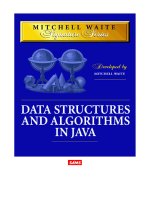Assignment 2 Data Structure and Algorithms 1649 Greenwich
Bạn đang xem bản rút gọn của tài liệu. Xem và tải ngay bản đầy đủ của tài liệu tại đây (1.32 MB, 18 trang )
ASSIGNMENT 2 FRONT SHEET
Qualification
BTEC Level 5 HND Diploma in Computing
Unit number and title
Unit 19: Data Structures and Algorithms
Submission date
31/08/2022
Date Received 1st submission
Re-submission Date
31/08/2022
Date Received 2nd submission
Student Name
Nguyen Manh Tung
Student ID
GCH200064
Class
GCH0907
Assessor name
Do Hong Quan
Student declaration
I certify that the assignment submission is entirely my own work and I fully understand the consequences of plagiarism. I understand that
making a false declaration is a form of malpractice.
Student’s signature
Grading grid
P4
P5
P6
P7
M4
M5
D3
D4
Summative Feedback:
Resubmission Feedback:
2.1
Grade:
Assessor Signature:
Internal Verifier’s Comments:
IV Signature:
Date:
Contents
Implement complex data structures and algorithms ....................................................................................... 2
I.
1.
2.
II.
1.1.
The difference of singly linked list and doubly linked list ................................................................... 2
1.2.
Implement singly linked list ................................................................................................................... 2
1.3.
Doubly linked list .................................................................................................................................... 5
Insert to middle of Linked list........................................................................................................................ 8
Implement error handling and report test results ....................................................................................... 9
1.
Testing plan ..................................................................................................................................................... 9
2.
Evaluation ...................................................................................................................................................... 10
III.
Discuss how asymptotic analysis can be used to assess the effectiveness of an algorithm ...................... 11
1.
Theta Notation............................................................................................................................................... 11
2.
Big O Notation............................................................................................................................................... 11
3.
Omega Notation ............................................................................................................................................ 12
4.
Example ......................................................................................................................................................... 12
IV.
V.
Singly linked list and doubly linked list ........................................................................................................ 2
Determine two ways in which the efficiency of an algorithm can be measured, illustrating your ........ 13
Reference ........................................................................................................................................................... 14
List of figures
Figure 1: Structure of singly linked list and doubly linked list ...................................................................................... 2
Figure 2: class Node ...................................................................................................................................................... 3
Figure 3: addLast of Singly linked list ............................................................................................................................ 3
Figure 4: removeLast of singly ...................................................................................................................................... 4
Figure 5: addFirst of singly ............................................................................................................................................ 4
Figure 6: removeFirst of singly...................................................................................................................................... 5
Figure 7: toString of singly and doubly ......................................................................................................................... 5
Figure 8: class Node of doubly ...................................................................................................................................... 6
Figure 9: addLast of doubly........................................................................................................................................... 6
Figure 10: removeLast of doubly .................................................................................................................................. 7
Figure 11: addFirst of doubly ........................................................................................................................................ 7
Figure 12: removeFirst of doubly.................................................................................................................................. 8
Figure 13: insertMiddle of doubly ................................................................................................................................ 9
Figure 14: Example of Theta notation (GeeksforGeeks, 2022) ................................................................................... 11
Figure 15: Example of Big O notation (GeeksforGeeks, 2022) ................................................................................... 12
Figure 16: Example of Omega Notation (GeeksforGeeks, 2022) ................................................................................ 12
Figure 17: Example of O(1) ......................................................................................................................................... 13
Figure 18: Example of O(n) ......................................................................................................................................... 13
Figure 19: Selection sort ............................................................................................................................................. 13
Figure 20: Change input from 5 to 10 elements ......................................................................................................... 14
List of tables
Table 1: Compare Singly and doubly linked list ............................................................................................................ 2
Table 2: Test plan .......................................................................................................................................................... 9
1
I.
Implement complex data structures and algorithms
1. Singly linked list and doubly linked list
1.1. The difference of singly linked list and doubly linked list
Singly linked list and doubly linked list are both list data structures used to store program information,
they are all built on the basis of Linked list structure, the elements are linked together by nodes.
Figure 1: Structure of singly linked list and doubly linked list
Difference between Singly linked list and doubly linked list
Table 1: Compare Singly and doubly linked list
Singly linked list
The elements are only joined by the next node,
Doubly linked list
Two-way join elements ie the following element
ie the previous element is connected to the
will store the position of the element before and
following element, but not vice versa
after it, both next and previous nodes exist
Only one-way access from head to tail
Can access from head to tail or tail to head
Requires 2 memory cells for each element
Requires 3 memory cells for each element
The next pointer of the last element is null
The next pointer of the last element is null and
the previous pointer of the first element is null
Time complexity is large
Time complexity is small
Space complexity is small
Space complexity is larger than singly but not
significantly
1.2. Implement singly linked list
Initialize MyLinkedList with generic <T>.
a. Class Node
2
Initialize the Node class to store the element's value and a next Node to store the next Node object.
The constructor takes as an input parameter T data, assigns Node's data equal to the parameter and
Node next equals null.
Figure 2: class Node
b. addLast Operation
Singly Linked list has 2 Nodes, head and tail are null, head is the first element, tail is the last element.
This operation will add the element to the end of the list.
If in case of list there is no element, assign head and tail equal to that Object Node (for first and last
element are equal to new Node).
If the list already has an element, then assign tail.next = new Node, then assign tail = new Node (the
next position of tail is new Node, then assign tail = new Node so that tail remains the last element).
Figure 3: addLast of Singly linked list
c. removeLast Operation
If the function has no element, it cannot be deleted, so it will return null.
3
If the function has one element, assign both head and tail = null, then return the deleted value
head.data.
In other cases, use a loop to move to the last element (next = null) and stop. Before reaching the last
element, there is an assignment to get the element near the end of the list.
After the loop is over, assign next to the last element = null, assign tail = the last element, and then
return the deleted value.
Figure 4: removeLast of singly
d. addFirst operation
The function adds to the head with the parameter T data, initializes the Node with the data parameter,
assigns that Node's next = head and assigns head = new Node. It will basically replace the head element
with the new Node and set next to the old head.
Figure 5: addFirst of singly
e. removeFirst operation
4
Function to remove the first element, if the list is empty, return null, if the list has an element, use the
intermediate variable tmp to store the head, assign head = the 2nd element then assign the next of tmp
= null, returns the deleted data value. It cuts the link between 2 elements and assigns the 2nd element to
the first element.
Figure 6: removeFirst of singly
f. toString
This function will use a loop to print out all the elements of the list as a string so that the user can check
the array.
Figure 7: toString of singly and doubly
1.3.Doubly linked list
Because doubly and singly are quite similar, I will explain the differences. Like the Singly linked list,
this function also has a Node class to store data, the next Node, in addition, it has an additional Node
previous to store the previous Node.
5
Figure 8: class Node of doubly
Like Singly's addLast, the only difference is that it assigns the previous of the newly added Node with
the old Node tail. Once done, increase the value of size.
a. addLast Operation
Like Singly's addLast, the only difference is that it assigns the previous of the newly added Node with
the old Node tail. Once done, increase the value of size.
Figure 9: addLast of doubly
b. removeLast operation
It is quite similar to singly, the difference is:
- In case there is 1 element, after the deletion is done, the size will decrease by 1.
- In case of multiple elements, the element near the end will also be saved and assigned next = null,
however, there is no need to use a loop to go from head but can go backwards from tail back with
previous.
6
Figure 10: removeLast of doubly
c. addFirst operation
The difference is that the previous head of the old head will be assigned to the new Node and increase
the size value by 1.
Figure 11: addFirst of doubly
d. addLast operation
The difference is that previous of the last element and next of the last element will be set to null to cut
off the link between it and the last element. Assign tail with the Node near the end, then reduce the size
by 1.
7
Figure 12: removeFirst of doubly
Also it has a method called toString but it's not different from Singly so I won't mention it again.
2. Insert to middle of Linked list.
To insert in the middle of the list, you must know the number of elements in the list, then go to that
position and insert. To perform the insertion, a Doubly linked list is used. I will show some methods to
insert in the middle of the list.
- Method 1: use a loop to go from head to the middle element and assign next of the element before it
and previous of the element after it equal to it (new element). Then assign its previous to the element
before it and next to the element after it.
- Method 2: Similar to method 1, but using a loop from tail.
My method is method 1.
Solution: In case the list is empty, call the addFirst operation to do it.
In other cases, find the middle of the list with the formula: size/2 + 1.
Create a variable that stores the starting position of the list (from the first element).
Use a loop with an iterator where the position variable is not larger than the size variable.
When these two variables are equal, that is, they are in the middle position, they will assign previous of
the middle element (Node middle) and the next of the previous element (Node before) with the new
Node, then assign the previous of the new Node with the Node before and next = Node middle. Increase
the value of size by 1.
8
Figure 13: insertMiddle of doubly
II.
Implement error handling and report test results
1. Testing plan
Table 2: Test plan
No
Scope
Operation
Testing
type
Normal
Input
Excepted output
Actual output Status
1
SinglyLink
edList
ADT:
MyLinked
List S1
addLast(Element
E)
S1: [3,2,5]
addLast(9)
As
expected
addLast(Element
E)
Normal
S1: [3]
addLast(6)
S1: [3,2,5,9]
Print S1 = “3 2 5
9”
S1: [3,6]
Print S1 = “3 6 ”
3
removeLast()
Normal
… and
a= removeLast()
S1: [3,2,5]
a=9
4
removeLast()
Validation
S1: []
a = removeLast
a = null
5
addFirst(Element Normal
E)
S1: [3,2,5]
addFirst(9)
6
removeFirst()
… and a
removeFirst()
2
Normal
Passed
S1: [6,3]
Failed
Print S1 = “6
3”
As
Passed
expected
NullPointerE
xception
S1: [9,3,2,5]
As
Print S1 = “9 3 2 expected
5”
= S1: [3,2,5]
As
a= 9
expected
Failed
Passed
Passed
9
7
removeFirst()
Validation
S1: []
a = removeFirst()
a = null
NullPointerE
xception
Failed
addLast(Element
E)
Normal
S1: []
addLast(9)
S1: [9]
Print S1 = “9 ”
As
expected
Passed
addLast(Element
E)
Normal
S1: [3,7,9]
addLast(6)
10
removeLast()
Normal
… and
a= removeLast()
S1: [3,7,9,6]
S1: [3,7,9]
Failed
Print S1 = “3 7 9 Print S1 = “3
6”
79”
S1: [3,2,5]
As
Passed
a=9
expected
11
removeLast()
Validation
S1: []
a = removeLast
12
addFirst(Element Normal
E)
S1: [1,2,3]
addFirst(9)
13
removeFirst()
Normal
… and a
removeFirst()
14
removeFirst()
Validation
S1: []
a = removeFirst()
a = null
insertMiddle(Ele
ment E)
Normal
S1:[1,2,3,4,5,6]
insertMiddle(7)
S1:[1,2,3,7,4,5,6] S1:[1,2,7,3,4, Failed
Print S1 = “1 2 3 5,6]
7456”
Print S1 = “1
273456”
insertMiddle(Ele
ment E)
Normal
S1: []
insertMiddle(8)
S1:[8]
Print S1 = “8 ”
8
9
15
16
DoublyLin
kedList
ADT:
DoublyLin
kedList
Question b
a = null
a=null
S1: [9,1,2,3]
As
Print S1 = “9 1 2 expected
3”
= S1: [1,2,3]
As
a= 9
expected
As
expected
S1:[]
Print S1 = “”
Passed
Passed
Passed
Passed
Failed
2. Evaluation
The test cases are recorded according to the execution process, so the failure cases have been fixed in
the implementation part, the source code is the source code after fixing the errors in the test plan.
Out of 16 test cases executed, 6 failed, most of the cases were test validation of the operation.
The data shows that validations often occur when the list is empty which in turn leads to failed functions.
In the program, the error is found to not perform the empty list condition check, which leads to error
cases. For example, when a list has no elements, assignments to remove the element cannot be
performed, thus creating an Exception NullPointerException which causes the program to stop
unexpectedly or cannot perform adding the element leaving the element unchanged.
10
Also, in question b, the formula for the middle position is wrong, causing the element to be inserted
incorrectly.
Solution: add conditional statements to check if the list is empty or not, modify the middle formula.
III.
Discuss how asymptotic analysis can be used to assess the effectiveness of an algorithm
Asymptotic analysis is simply understood as a method of calculating the performance of an algorithm,
how it affects the program in time or space, finding a most general formula for all the algorithms.
program, from which there will be a suitable application for each program.
It is usually classified into worst case (worst case), average case (average case) and best case (best case).
1. Theta Notation
Theta Notation is bounded around the upper and lower bounds of the algorithm (GeeksforGeeks, 2022),
so it represents the 2 limits of the algorithm, from which the average running time of the algorithm is
calculated. From there, it is applied to find the average case of the algorithm. Average case is the average
time of each run of an algorithm, so Theta Notation is the right choice to analyze the average case of the
algorithm.
Figure 14: Example of Theta notation (GeeksforGeeks, 2022)
2. Big O Notation
Like Theta Notation, Big O Notation is also used for asymptotic analysis of algorithms. Big O is the
method of analyzing the upper limit of an algorithm (GeeksforGeeks, 2022), so it is applied to calculate
the worst case for the algorithm. This method calculates the maximum number of statements or functions
to be executed of an algorithm, thereby figuring out their dependence on the input. Finally, give the
result of the worst case.
11
Figure 15: Example of Big O notation (GeeksforGeeks, 2022)
3. Omega Notation
Omega Notation is used to analyze the lower asymptote of an algorithm so it is used for the best case
analysis of an algorithm (GeeksforGeeks, 2022). An algorithm with a small best case will have a very
fast running speed when entering a good case. However, it is not used too much because most developers
only care and optimize the worst case.
Figure 16: Example of Omega Notation (GeeksforGeeks, 2022)
4. Example
The Big O Notation asymptotic analysis method will be used to calculate the Worst case of some
algorithms.
a. O(1)
12
Figure 17: Example of O(1)
A simple algorithm to check that n is divisible by 2, the if statement is executed at most and it is 1
time, even if n = 4, 5, 6 changes, the number of if runs does not change so it does not depend on n.
We have the worst case of this algorithm as O(1).
b. O(n)
Figure 18: Example of O(n)
Algorithm prints numbers from 0 to n, print statement will be run n times, so it depends on n so
worst case of this algorithm is O(n).
IV.
Determine two ways in which the efficiency of an algorithm can be measured, illustrating
your
Selection sort algorithm
Figure 19: Selection sort
The time complexity of selection sort is calculated as the maximum number of times if(arr[min] >
arr[j]) is executed. We will consider 2 loops, the first loop runs (4) times, the second loop runs 4 times.
Hence T(5) = 4*4 = 16 times.
When input increments from 5 elements to 10 elements.
13
Figure 20: Change input from 5 to 10 elements
The first loop is run 9 times, the second loop is 9 times. T(10) = 9*9 = 81
We see the general formula of T(n) = (n-1) * (n-1) so the Complexity of the selection sort is O(n2). Time
complexity will increase with the order of squares for the number of input elements.
The space complexity of the selection sort will consist of two parts: the number of input cells and the
number of generated memory cells. Most devices today are 64bit, Ram 8, 16GB, so an int memory cell
will occupy 8bytes, bool takes up 1 byte in RAM.
The input storage capacity of 5 elements is: 5*8bytes = 40 bytes.
The generated capacity: includes variables i, j, arr.length, arr.length – 1,min, j, temp, 2 boolean variables
of the conditional => 58 bytes.
When element increments from 5 to 10:
The input storage capacity of 10 elements is: 10*8bytes = 80 bytes.
The generated capacity: includes variables i, j, arr.length, arr.length – 1,min, j, temp, 2 boolean variables
of the conditional => 58 bytes.
We see that the generated capacity does not change despite increasing the number of input elements.
Increased input storage is something that happens in all algorithms, so we'll ignore them.
So the conclusion is that the Space complexity of the selection sort is O(1) which means it doesn't change
even if the input changes.
V.
Reference
GeeksforGeeks. 2022. What are Asymptotic Notations in Complexity Analysis of Algorithms. [online]
Available
at:
/>(Accessed 31 August 2022).
14
Powered by TCPDF (www.tcpdf.org)
Index of comments
2.1
- P4: Singly and Doubly Linked-List have been compared and implemented successfully, but the work lacks
illustrated figures to clarify these implementations. One good thing is a solution has been provided for solving task
(b).
- P5: A number of test cases have been presented. Some potential errors are revealed. The testing result, then, has
been evaluated.
- P6: The discussion about asymptotic analysis is presented with some examples.
- P7: Given an example of selection sort, time complexity & Space complexity have been described.
Powered by TCPDF (www.tcpdf.org)









